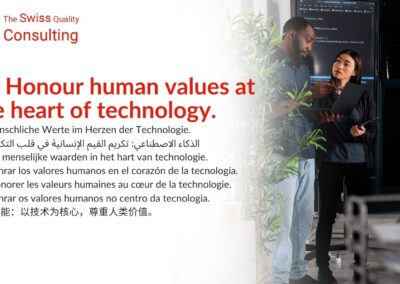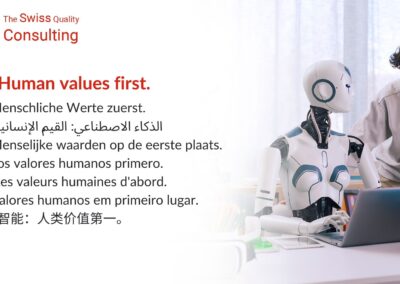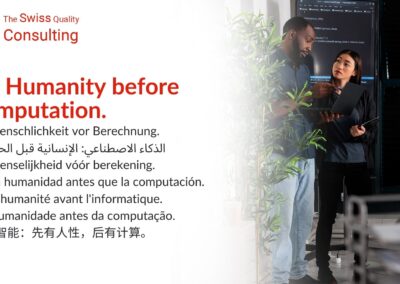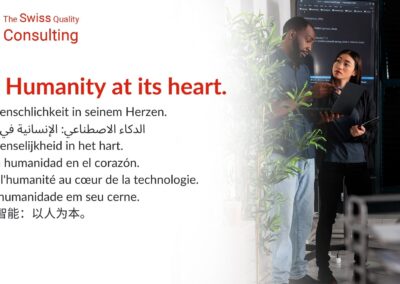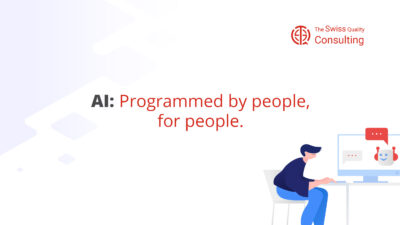Human-Centric Leadership: Embracing Diversity in the Era of Technological Advancement
In the fast-paced world of business, where technological advancements are reshaping industries, it is crucial to recognize and appreciate the unique qualities that humans bring to the table. The quote, “People assume that computers will do everything that humans do. Not good. People are different from each other and they are all really different from computers,” serves as a poignant reminder of the irreplaceable value of human capabilities in the face of evolving technology. This article, tailored for business executives, mid-level managers, and entrepreneurs, explores the symbiotic relationship between humans and technology, emphasizing the significance of diversity, effective communication, and leadership skills.
The Limitations of Artificial Intelligence
The rise of artificial intelligence (AI) has undoubtedly pushed the boundaries of what’s possible. But amidst the awe-inspiring capabilities of machines, it’s crucial to remember the irreplaceable value of the human element, especially in the intricate dance of change management. While computers excel at crunching data and following algorithms, they lack the vital ingredients that truly drive successful change: emotional intelligence, creativity, and adaptability.
Imagine navigating a treacherous mountain pass. AI, with its powerful processing and mapping capabilities, might excel at calculating the most efficient route. But it can’t sense the shifting winds, gauge the morale of your team, or adapt to a sudden avalanche. These are nuances that require the human touch, the intuitive understanding and emotional intelligence that allows us to navigate the unpredictable terrain of change with empathy and agility.
Think of your organization as a complex ecosystem, teeming with diverse personalities, motivations, and anxieties. AI can analyze data and identify patterns, but it can’t grasp the human story. It can’t connect with individuals on an emotional level, address their concerns with genuine empathy, or inspire them to embrace change with shared purpose. These are the realms where human leadership shines, where creativity, empathy, and the ability to build trust and consensus pave the way for successful transformation.
This doesn’t mean we should shun AI entirely. On the contrary, leveraging AI as a powerful tool to gather data, identify trends, and automate repetitive tasks frees up human leaders to focus on what they do best: leading, inspiring, and navigating the human complexities of change.
Here’s how to strike the right balance:
Empower Human Expertise: Don’t replace human decision-making with AI algorithms. Leverage AI for insights, but empower leaders to make informed choices based on the human story behind the data.
Focus on Emotional Intelligence: Cultivate leaders who can tap into emotional intelligence, build trust, and foster empathy throughout the change process.
Embrace Adaptability: Encourage a culture of learning and agility, where both leaders and teams can adapt to unforeseen challenges and embrace new possibilities.
Remember, AI is a powerful tool, but it’s just that – a tool. The success of change management hinges on the unique abilities that define us as humans: our empathy, creativity, and unwavering spirit in the face of change. So, harness the power of technology, but never lose sight of the irreplaceable value of the human touch. It’s the bridge that will guide your organization, not just through change, but towards a brighter future built on human connection and shared purpose.
Executive Coaching for Human-Centric Leadership
Executive coaching services play a pivotal role in nurturing human-centric leadership skills. Leaders need to recognize the nuances of individual strengths, motivations, and communication styles within their teams. Coaching empowers executives to harness the power of diversity, fostering an environment where employees feel valued for their unique contributions. Effective leadership, as opposed to a one-size-fits-all approach, involves understanding and leveraging the distinct qualities that humans bring to the workplace.
The Importance of Effective Communication
Effective communication emerges as a cornerstone in bridging the gap between humans and technology. In a landscape where business success is increasingly intertwined with technological integration, the ability to convey complex ideas, emotions, and strategies becomes paramount. Leaders must prioritize communication skills in their teams, ensuring that the human touch is not lost amidst the data-driven processes facilitated by technology.
Strategic Planning in a Hybrid Ecosystem
Strategic planning takes on new dimensions in a business landscape where humans and technology coexist. Leaders must devise plans that leverage the strengths of both, acknowledging that certain aspects of decision-making, innovation, and relationship-building are uniquely human. The integration of Generative Artificial Intelligence (GAI) can enhance efficiency, but a comprehensive strategy should ensure that the human element remains at the forefront.
Celebrating Organizational Culture and Diversity
Organizational culture is a reflection of its people. While technology can optimize processes, it is the collective personality, creativity, and dedication of the workforce that define a company’s culture. Leaders should celebrate and cultivate diversity, recognizing that each individual contributes to the richness of the organizational tapestry. This approach fosters a sense of belonging and loyalty, elements that technology alone cannot instill.
Conclusion: Embracing the Future with a Human-Centric Approach
In conclusion, the intersection of humans and technology in the business world demands a balanced and human-centric approach. As we navigate change management, embrace executive coaching, prioritize effective communication, and integrate technology into strategic planning, let us not forget the irreplaceable qualities that make us distinctly human. The quote serves as a call to action, urging business leaders to champion diversity, celebrate individuality, and foster an environment where the synergy between humans and technology propels organizations toward unparalleled success.
#HumanCentricLeadership #EffectiveCommunication #StrategicPlanning #OrganizationalCulture







